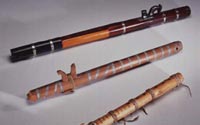Courting Flutes

Native American flutes
Red Fox, Quapaw
Miami, Oklahoma, 1900-1925
John Spear, maker
Nebraska Winnebago, 1922
Henry Johnson, maker
Ute, 1921
Music Division
![[Anthony Lujan, (Deer of the Yellow Willows)]](images/at0151.11s-th.jpg)
Thurlow
Lieurance,
photographer (1878–1963)
[Anthony Lujan, (Deer of the Yellow Willows)]
Taos Pueblo, September 1913
Photograph, hand-applied emulsion (platinum or palladium) on artisit’s
paper. No. 136
Music Division
Gift of Dayton C. Miller, 1941 (151.11)
|
Though unison singing accompanied by one or more drums or rattles
is the more familiar musical mode, flutes played special roles in
Native American music--enhancing ritual and serving as outlets for
individual expression.
Flutes ranged from simple whistles made of hollowed-out small
animal bone, to large and colorfully decorated instruments made
of carved wood and other elements lashed together. The latter were
most common, and as instruments devoted to courting, religious,
and healing uses, no two flutes were alike. Their sizes and forms
depended on available materials and the talents of each individual
flutist-craftsman. Even the placement of finger holes on the courting
flutes was a personal choice. The resulting scale became the player's
personal musical expression, and, as the flutes were used as solo
instruments, there was no need for more consistent scales.
|

